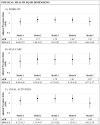Health-related quality of life inequalities by sexual orientation: Results from the Barcelona Health Interview Survey
- PMID: 29364938
- PMCID: PMC5783362
- DOI: 10.1371/journal.pone.0191334
Health-related quality of life inequalities by sexual orientation: Results from the Barcelona Health Interview Survey
Abstract
Background: Studies on health-related quality of life (HRQoL) inequalities according to sexual orientation are scarce. The aim of this study was to assess HRQoL inequalities between lesbian, gay, and bisexual (LGB) people and heterosexuals in the 2011 Barcelona population, to describe the extent to which sociodemographic characteristics, health-related behaviors, and chronic conditions could explain such inequalities, and to understand if they are sexual orientation inequities.
Methods: In the 2011 Barcelona Health Interview Survey 3277 adults answered the EQ-5D, which measures five dimensions of HRQoL summarized into a single utility index (1 = perfect health, 0 = death). To assess HRQoL differences by sexual orientation we constructed Tobit models for the EQ-5D index, and Poisson regression models for the EQ-5D dimensions. In both cases, nested models were constructed to assess the mediator role of selected variables.
Results: After adjusting by socio-demographic variables, the LGB group presented a significantly lower EQ-5D index than heterosexuals, and higher prevalence ratios of problems in physical EQ-5D dimensions among both genders: adjusted prevalence ratio (aPR) = 1.70 for mobility (p = 0.046) and 2.11 for usual activities (p = 0.019). Differences in mental dimensions were only observed among men: aPR = 3.15 for pain/discomfort (p = 0.003) and 2.49 for anxiety/depression (p = 0.030). All these differences by sexual orientation disappeared after adding chronic conditions and health-related behaviors in the models.
Conclusion: The LGB population presented worse HRQoL than heterosexuals in the EQ-5D index and most dimensions. Chronic conditions, health-related behaviors and gender play a major role in explaining HRQoL differences by sexual orientation. These findings support the need of including sexual orientation into the global agenda of health inequities.
Conflict of interest statement
Figures


References
-
- Truman BI, Smith KC, Roy K, Chen Z, Moonesinghe R, Zhu J, et al. Rationale for regular reporting on health disparities and inequalities—United States. MMWR Suppl 2011;60(1):3–10. - PubMed
-
- Hatzenbuehler ML, Bellatorre A, Lee Y, Finch BK, Muennig P, Fiscella K. Structural stigma and all-cause mortality in sexual minority populations. Soc Sci Med 2014;103:33–41. doi: 10.1016/j.socscimed.2013.06.005 - DOI - PMC - PubMed
-
- Sandfort TG, Bakker F, Schellevis FG, Vanwesenbeeck I. Sexual orientation and mental and physical health status: findings from a Dutch population survey. Am J Public Health 2006;96(6):1119–1125. doi: 10.2105/AJPH.2004.058891 - DOI - PMC - PubMed
-
- Cochran SD, Mays VM. Physical health complaints among lesbians, gay men, and bisexual and homosexually experienced heterosexual individuals: results from the California Quality of Life Survey. Am J Public Health 2007;97(11):2048–2055. doi: 10.2105/AJPH.2006.087254 - DOI - PMC - PubMed
-
- Ward BW, Dahlhamer JM, Galinsky AM, Joestl SS. Sexual orientation and health among U.S. adults: national health interview survey, 2013. Natl Health Stat Report 2014;(77):1–10. - PubMed
Publication types
MeSH terms
Grants and funding
LinkOut - more resources
Full Text Sources
Other Literature Sources
Miscellaneous

